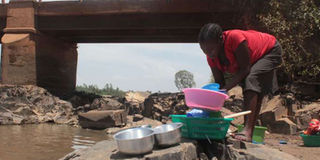Hygiene, screening to help minimise disease burden

Jane Apiyo washes utensils using water from River Nzoia. As the rainy season begins, scientists are warning that lack of proper sanitation and clean drinking water could escalate disease outbreaks. PHOTO | TOM OTIENO | NATION MEDIA GROUP
What you need to know:
- Some of the worst-hit counties include Wajir, Marsabit, Tharaka-Nithi, Tana River, Meru, Busia, Nandi, Garissa, Nakuru, Siaya, Migori and Nairobi.
- And now, as the rainy season begins, scientists are warning that lack of proper sanitation and clean drinking water could escalate these outbreaks.
- Medical charity Médecins Sans Frontières (Doctors Without Borders) calls for setting up of strong emergency measures to address the now perennial cholera problem.
Unpredictable weather such as the recent El Niño rains have magnified the health threat with diseases such as cholera, typhoid, dengue fever, hepatitis A, diarrhoea and malaria resurfacing in areas where they had been contained.
This, combined with poor sanitation, lack of clean drinking water and unhygienic handling of food, could provide a major challenge to the health system, scientists have warned.
According to the Principal Secretary for Health Nicholas Muraguri, it is the mandate of county governments to screen food handlers and contain diseases like cholera.
“The cholera outbreak is largely due to the mushrooming of unhygienic food outlets and improper screening of food handlers,” he said in a past interview.
There have been suggestions that food handlers should be regularly vaccinated and issued with certificates through county health officials to minimise transmission of diseases like typhoid and cholera.
This could require the government to buy oral and injectable vaccines in bulk.
Yet, as the national and county governments try to sort out the perennial problem, more than half of the country is grappling with a persistent cholera outbreak since 2014 that has so far killed at least 200 people.
This has led the Health ministry to not only heighten disease surveillance but also issue a cholera outbreak situation report.
Some of the worst-hit counties include Wajir, Marsabit, Tharaka-Nithi, Tana River, Meru, Busia, Nandi, Garissa, Nakuru, Siaya, Migori and Nairobi.
Mombasa County seems to be dealing with a different infectious disease altogether.
Last month, it was reported that the county was dealing with an outbreak of Hepatitis A, a viral liver disease transmitted through ingestion of contaminated food and water or direct contact with an infected person.
An outbreak of Hepatitis E has also been reported in Eldoret.
TAKE ACTION
And now, as the rainy season begins, scientists are warning that lack of proper sanitation and clean drinking water could escalate these outbreaks.
The World Health Organization warns that emerging or re-emerging infectious diseases now cause one-third of all deaths around the world, with developing countries being at the greatest risk.
Dr Andrew Githeko, a lead scientist at the Kenya Medical Research Institute, says that unless action is taken to minimise the impact of these outbreaks, the country may plunge into a crisis.
“We have had a cholera outbreak for two years now. It has been happening during the dry season due to poor hygiene and now that the rain is here, it may get worse because rain water contaminates the shallow boreholes which people drink from,” explains Dr Githeko.
He also points out that although the country has been able to reduce the numbers of people affected by malaria, outbreaks are likely to be reported in highland areas.
Medical charity Médecins Sans Frontières (Doctors Without Borders) calls for setting up of strong emergency measures to address the now perennial cholera problem.
“Unless stronger and immediate emergency measures are put in place, there is a very high risk that we will see another increase,” says Gaudry, adding that there is need to educate people on hygiene and proper handling of water and food.
In a recent report, the United Nations Children’s Fund estimates that by the year 2030, climate change could be responsible for an additional 38,000 annual deaths due to heat exposure among elderly people, 48,000 due to diarrhoea, 60,000 due to malaria, and about 95,000 due to childhood under nutrition.





